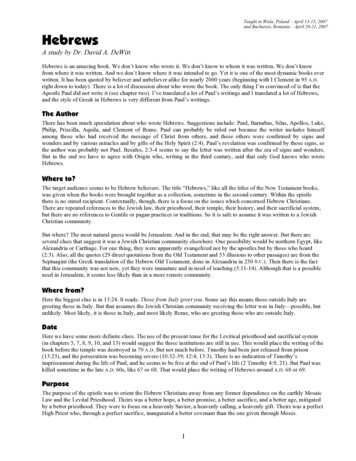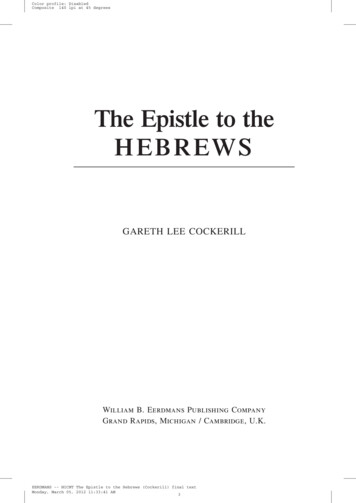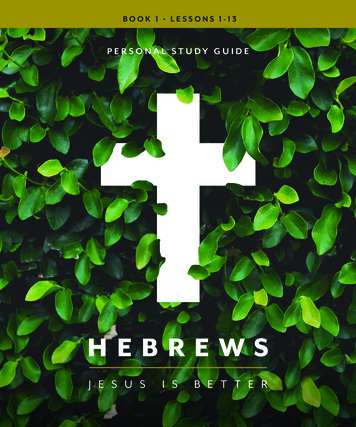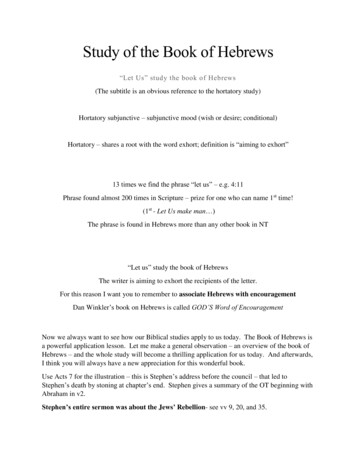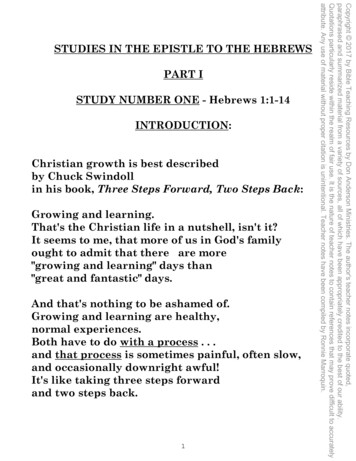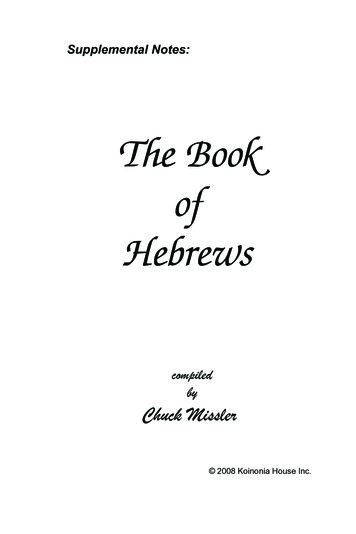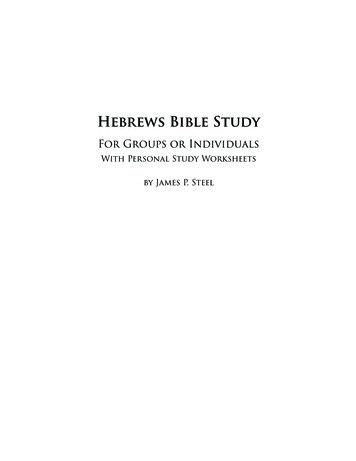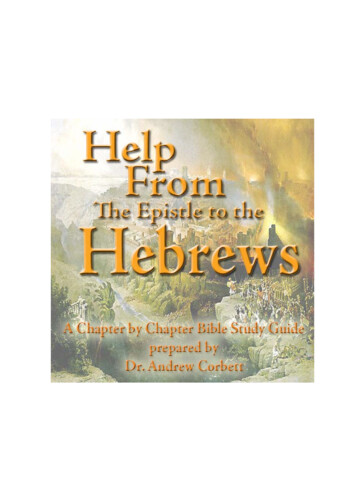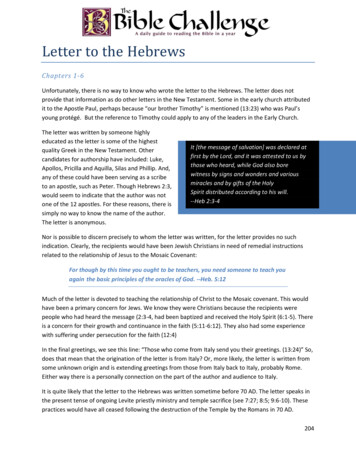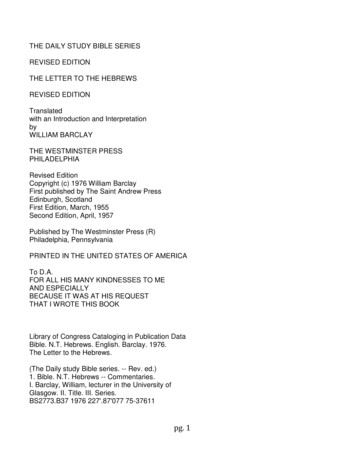
Transcription
THE DAILY STUDY BIBLE SERIESREVISED EDITIONTHE LETTER TO THE HEBREWSREVISED EDITIONTranslatedwith an Introduction and InterpretationbyWILLIAM BARCLAYTHE WESTMINSTER PRESSPHILADELPHIARevised EditionCopyright (c) 1976 William BarclayFirst published by The Saint Andrew PressEdinburgh, ScotlandFirst Edition, March, 1955Second Edition, April, 1957Published by The Westminster Press (R)Philadelphia, PennsylvaniaPRINTED IN THE UNITED STATES OF AMERICATo D.A.FOR ALL HIS MANY KINDNESSES TO MEAND ESPECIALLYBECAUSE IT WAS AT HIS REQUESTTHAT I WROTE THIS BOOKLibrary of Congress Cataloging in Publication DataBible. N.T. Hebrews. English. Barclay. 1976.The Letter to the Hebrews.(The Daily study Bible series. -- Rev. ed.)1. Bible. N.T. Hebrews -- Commentaries.I. Barclay, William, lecturer in the University ofGlasgow. II. Title. III. Series.BS2773.B37 1976 227'.87'077 75-37611pg. 1
ISBN 0-664-21312-XISBN 0-664-24112-3 pbk.GENERAL INTRODUCTIONThe Daily Study Bible series has always had one aim--to convey the results of scholarship to theordinary reader. A. S. Peake delighted in the saying that he was a "theological middleman", and Iwould be happy if the same could be said of me in regard to these volumes. And yet the primaryaim of the series has never been academic. It could be summed up in the famous words ofRichard of Chichester's prayer--to enable men and women "to know Jesus Christ more clearly, tolove him more dearly, and to follow him more nearly".It is all of twenty years since the first volume of The Daily Study Bible was published. Theseries was the brain-child of the late Rev. Andrew McCosh, M.A., S.T.M., the then Secretary andManager of the Committee on Publications of the Church of Scotland, and of the late Rev. R. G.Macdonald, O.B.E., M.A., D.D., its Convener.It is a great joy to me to know that all through the years The Daily Study Bible has been used athome and abroad, by minister, by missionary, by student and by layman, and that it has beentranslated into many different languages. Now, after so many printings, it has become necessaryto renew the printer's type and the opportunity has been taken to restyle the books, to correctsome errors in the text and to remove some references which have become outdated. At the sametime, the Biblical quotations within the text have been changed to use the Revised StandardVersion, but my own original translation of the New Testament passages has been retained at thebeginning of each daily section.There is one debt which I would be sadly lacking in courtesy if I did not acknowledge. Thework of revision and correction has been done entirely by the Rev. James Martin, M.A., B.D.,minister of High Carntyne Church, Glasgow. Had it not been for him this task would never havebeen undertaken, and it is impossible for me to thank him enough for the selfless toil he has putinto the revision of these books.It is my prayer that God may continue to use The Daily Study Bible to enable men better tounderstand His word.Glasgow WILLIAM BARCLAYCONTENTSGeneral IntroductionIntroduction to The Letter to the Hebrewspg. 2
The End of Fragments (Heb.1:1-3)Above the Angels (Heb.1:4-14)The Salvation We Dare not Neglect (Heb.2:1-4)The Recovery of Man's Lost Destiny (Heb.2:5-9)The Essential Suffering (Heb.2:10-18)Greater than the Greatest (Heb.3:1-6)While Today Still Lasts (Heb.3:7-19)The Rest We Dare Not Miss (Heb.4:1-10)The Terror of the Word (Heb.4:11-13)The Perfect High Priest (Heb.4:14-16)At Home with Man and God (Heb.5:1-10)The Refusal to Grow Up (Heb.5:11-14)The Necessity of Progress (Heb.6:1-3)Crucifying Christ Again (Heb.6:4-8)The Brighter Side (Heb.6:9-12)The Sure Hope (Heb.6:13-20)A Priest after the Order of Melchizedek (Heb.7)The True King and the True Priest (Heb.7:1-3)The Greatness of Melchizedek (Heb.7:4-10)The New Priest and the New Way (Heb.7:11-20)The Greater Priesthood (Heb.7:21-25)The High Priest We Need (Heb.7:26-28)The Way to Reality (Heb.8:1-6)The New Relationship (Heb.8:7-13)The Glory of the Tabernacle (Heb.9:1-5)The Only Entry to the Presence of God (Heb.9:6-10)The Sacrifice which Opens the Way to God (Heb.9:11-14)The Only Way in which Sins Can be Forgiven (Heb.9:15-22)The Perfect Purification (Heb.9:23-28)The Only True Sacrifice (Heb.10:1-10)The Finality of Christ (Heb.10:11-18)The Meaning of Christ for Us (Heb.10:19-25)The Threat at the Heart of Things (Heb.10:26-31)The Danger of Drift (Heb.10:32-39)The Christian Hope (Heb.11:1-3)The Faith of the Acceptable Offering (Heb.11:4)Walking with God (Heb.11:5-6)The Man who Believed in God's Message (Heb.11:7)The Adventure and Patience of Faith (Heb.11:8-10)Believing the Incredible (Heb.11:11-12)Sojourners and Strangers (Heb.11:13-16)The Supreme Sacrifice (Heb.11:17-19)The Faith which Defeats Death (Heb.11:20-22)Faith and Its Secret (Heb.11:23-29)The Faith which Defied the Facts (Heb.11:30-31)The Heroes of the Faith (Heb.11:32-34)pg. 3
The Defiance of Suffering (Heb.11:35-40)The Race and the Goal (Heb.12:1-2)The Standard of Comparison (Heb.12:3-4)The Discipline of God (Heb.12:5-11)Duties, Aims, and Dangers (Heb.12:12-17)The Terror of the Old and the Glory of the New (Heb.12:18-24)The Greater Obligation (Heb.12:25-29)The Marks of the Christian Life (Heb.13:1-6)The Leaders and The Leader (Heb.13:7-8)The Wrong and the Right Sacrifice (Heb.13:9-16)Obedience and Prayer (Heb.13:17-20)A Prayer, a Greeting, and a Blessing (Heb.13:20-24)INTRODUCTION TO THE LETTER TO THE HEBREWS. 6THE END OF FRAGMENTS . 12ABOVE THE ANGELS . 15THE SALVATION WE DARE NOT NEGLECT. 17THE RECOVERY OF MAN'S LOST DESTINY . 19THE ESSENTIAL SUFFERING . 20GREATER THAN THE GREATEST . 22WHILE TODAY STILL LASTS . 24THE REST WE DARE NOT MISS . 26THE TERROR OF THE WORD. 28THE PERFECT HIGH PRIEST . 30AT HOME WITH MAN AND GOD . 32THE REFUSAL TO GROW UP . 35THE NECESSITY OF PROGRESS . 36CRUCIFYING CHRIST AGAIN . 39THE BRIGHTER SIDE . 41THE SURE HOPE . 43pg. 4
A PRIEST AFTER THE ORDER OF MELCHIZEDEK . 44THE TRUE KING AND THE TRUE PRIEST . 49THE GREATNESS OF MELCHIZEDEK . 51THE NEW PRIEST AND THE NEW WAY . 53THE GREATER PRIESTHOOD . 54THE HIGH PRIEST WE NEED . 56THE WAY TO REALITY . 58THE NEW RELATIONSHIP . 60THE GLORY OF THE TABERNACLE . 63THE ONLY ENTRY TO THE PRESENCE OF GOD. 65THE SACRIFICE WHICH OPENS THE WAY TO GOD . 67THE ONLY WAY IN WHICH SINS CAN BE FORGIVEN. 70THE PERFECT PURIFICATION . 72THE ONLY TRUE SACRIFICE . 74THE FINALITY OF CHRIST . 76THE MEANING OF CHRIST FOR US . 78THE THREAT AT THE HEART OF THINGS . 81THE DANGER OF DRIFT . 82THE CHRISTIAN HOPE. 84THE FAITH OF THE ACCEPTABLE OFFERING . 86WALKING WITH GOD . 87THE MAN WHO BELIEVED IN GOD'S MESSAGE . 92THE ADVENTURE AND THE PATIENCE OF FAITH . 94BELIEVING THE INCREDIBLE . 96SOJOURNERS AND STRANGERS . 97pg. 5
THE SUPREME SACRIFICE . 99THE FAITH WHICH DEFEATS DEATH. 100FAITH AND ITS SECRET . 101THE FAITH WHICH DEFIED THE FACTS . 104THE HEROES OF THE FAITH . 106THE DEFIANCE OF SUFFERING . 107THE RACE AND THE GOAL . 111THE STANDARD OF COMPARISON . 112THE DISCIPLINE OF GOD . 113DUTIES, AIMS AND DANGERS . 115THE TERROR OF THE OLD AND THE GLORY OF THE NEW . 119THE GREATER OBLIGATION. 121THE MARKS OF THE CHRISTIAN LIFE . 122THE LEADERS AND THE LEADER . 125THE WRONG AND THE RIGHT SACRIFICE . 126OBEDIENCE AND PRAYER . 128A PRAYER, A GREETING AND A BLESSING . 129INTRODUCTION TO THE LETTER TO THE HEBREWSGOD FULFILLS HIMSELF IN MANY WAYSReligion has never been the same thing to all men. "God," as Tennyson said, "fulfills himself inmany ways." George Russell said: "There are as many ways of climbing to the stars as there arepeople to climb." There is a well-known saying which tells us very truly and very beautifully that"God has his own secret stairway into every heart." Broadly speaking, there have been four greatconceptions of religion.pg. 6
(i) To some men it is inward fellowship with God. It is a union with Christ so close and so intimatethat the Christian can be said to live in Christ and Christ to live in him. That was Paul's conceptionof religion. To him it was something which mystically united him with God.(ii) To some religion is what gives a man a standard for life and a power to reach that standard. Onthe whole that is what religion was to James and to Peter. It was something which showed themwhat life ought to be and which enabled them to attain it.(iii) To some men religion is the highest satisfaction of their minds. Their minds seek and seek untilthey find that they can rest in God. It was Plato who said that "the unexamined life is the life notworth living." There are some men who must understand or perish. On the whole that is whatreligion was to John. The first chapter of his gospel is one of the greatest attempts in the world tostate religion in a way that really satisfies the mind.(iv) To some men religion is access to God. It is that which removes the barriers and opens thedoor to his living presence. That is what religion was to the writer of the Letter to the Hebrews. Withthat idea his mind was dominated. He found in Christ the one person who could take him into thevery presence of God. His whole idea of religion is summed up in the great passage in Heb.10:1923."Therefore, since we have confidence to enter the sanctuary by the blood of Jesus, by the new andliving way which he opened for us through the curtain, that is, through his flesh, let us draw nearwith a true heart in full assurance of faith."If the writer to the Hebrews had one text it was: "Let us draw near."THE DOUBLE BACKGROUNDThe writer to the Hebrews had a double background into both of which this idea came. He had aGreek background Ever since the time of Plato, five hundred years before, the Greeks had beenhaunted by the contrast between the real and the unreal, the seen and the unseen, the temporaland the eternal. It was the Greek idea that somewhere there was a real world of which this wasonly a shadowy and imperfect copy. Plato had the idea that somewhere there was a world ofperfect forms or ideas or patterns, of which everything in this world was an imperfect copy. To takea simple instance, somewhere there was laid up the pattern of a perfect chair of which all thechairs in this world were inadequate copies. Plato said: "The Creator of the world had designedand carried out his work according to an unchangeable and eternal pattern of which the world isbut a copy." Philo, who took his ideas from Plato, said: "God knew from the beginning that a faircopy could never come into being apart from a fair pattern; and that none of the objectsperceivable by sense could be flawless which was not modelled after an archetype and spiritualidea, and thus, when he prepared to create this visible world, he shaped beforehand the idealworld in order to constitute the corporeal after the incorporeal and godlike pattern." When Cicerowas talking of the laws men know and use on earth, he said: "We have no real and life-likelikeness of real law and genuine justice; all we enjoy is a shadow and a sketch."pg. 7
The thinkers of the ancient world all had this idea that somewhere there is a real world of whichthis one is only a kind of imperfect copy. Here we can only guess and grope; here we can workonly with copies and imperfect things. But in the unseen world there are the real and perfect things.When Newman died they erected a statue to him, and on the pedestal of it are the Latin words: Abumbris et imaginibus ad veritatem, "Away from the shadows and the semblances to the truth." Ifthat be so, clearly the great task of this life is to get away from the shadows and the imperfectionsand to reach reality. This is exactly what the writer to the Hebrews claims that Jesus Christ canenable us to do. To the Greek the writer to the Hebrews said: "All your lives you have been tryingto get from the shadows to the truth. That is just what Jesus Christ can enable you to do."THE HEBREW BACKGROUNDBut the writer to the Hebrews also had a Jewish background. To the Jew it was always dangerousto come too near to God. "Man," said God to Moses, "shall not see me and live" (Exo.33:20). It wasJacob's astonished exclamation at Peniel: "I have seen god face to face and yet my life ispreserved" (Gen.32:30). When Manoah realized who his visitor had been, he said in terror to hiswife: "We shall surely die, for we have seen God." The great day of Jewish worship was the Day ofAtonement. That was the one day of all the year when the High Priest entered the Holy of Holieswhere the very presence of God was held to dwell. No man ever entered in except the High Priest,and he only on that day. When he did, the law laid it down that he must not linger in the Holy Placefor long "lest he put Israel in terror." It was dangerous to enter the presence of God and if a manwaited too long he might be struck dead. In view of this there entered into Jewish thought the ideaof a covenant. God, in his grace and in a way that was quite unmerited, approached the nation ofIsrael and offered them a special relationship with himself. But this unique access to God wasconditional on the observance by the people of the law that he gave to them. We can see thisrelationship being entered into and this law being accepted in the dramatic scene in Exo.24:3-8.So then Israel had access to God, but only if she kept the law. To break the law was sin, and sinput up a barrier which stopped the way to God. It was to take away that barrier that the system ofthe Levitical priesthood and sacrifices was constructed. The law was given; man sinned; the barrierwas up; the sacrifice was made; and the sacrifice was designed to open the closed way to God.But the experience of life was that this was precisely what sacrifice could not do. It was proof of theineffectiveness of the whole system that sacrifice had to go on and on and on. It was a losing andineffective battle to remove the barrier that sin had erected between man and God.THE PERFECT PRIEST AND THE PERFECT SACRIFICEWhat men needed was a perfect priest and a perfect sacrifice, someone who was such that hecould bring to God a sacrifice which once and for all opened the way of access to him. That, saidthe writer to the Hebrews, is exactly what Christ did. He is the perfect priest because he is at onceperfectly man and perfectly God. In his manhood he can take man to God and in his Godhead hecan take God to man. He has no sin. The perfect sacrifice he brings is the sacrifice of himself, asacrifice so perfect that it never needs to be made again. To the Jew the writer to the Hebrewssaid: "All your lives you have been looking for the perfect priest who can bring the perfect sacrificeand give you access to God. You have him in Jesus Christ and in him alone."pg. 8
To the Greek the writer to the Hebrews said: "You are looking for the way from the shadows toreality; you will find it in Jesus Christ." To the Jew the writer to the Hebrews said: "You are lookingfor that perfect sacrifice which will open the way to God which your sins have closed; you will find itin Jesus Christ." Jesus was the one person who gave access to reality and access to God. That isthe key-thought of this letter.THE RIDDLE OF THE NEW TESTAMENTSo much is clear but when we turn to the other questions of introduction Hebrews is wrapped inmystery. E. F. Scott wrote: "The Epistle to the Hebrews is in many respects the riddle of the NewTestament." When it was written, to whom it was written, and who wrote it are questions at whichwe can only guess. The very history of the letter shows how its mystery is to be treated with acertain reserve and suspicion. It was a long time before it became an unquestioned NewTestament book. The first list of New Testament books, The Muratorian Canon, compiled aboutA.D. 170, does not mention it at all. The great Alexandrian scholars. Clement and Origen, knew itand loved it but agreed that its place as scripture was disputed. Of the great African fathers,Cyprian never mentions it and Tertullian knows that its place was disputed. Eusebius, the greatChurch historian, says that it ranked among the disputed books. It was not until the time ofAthanasius, in the middle of the fourth century, that Hebrews was definitely accepted as a NewTestament book, and even Luther was not too sure about it. It is strange to think how long thisgreat book had to wait for full recognition.WHEN WAS IT WRITTEN?The only information we have comes from the letter itself. Clearly it is written for what we might callsecond generation Christians (Heb.2:3). The story was transmitted to its recipients by those whohad heard the Lord. The community to whom it was written were not new to the Christian faith; theyought to have been mature (Heb.5:12). They must have had a long history for they are summonedto look back on the former days (Heb.10:32). They had a great history behind them and heroicmartyr figures on which they ought to look back for inspiration (Heb.13:7).The thing that will help us most in dating the letter is its references to persecution. It is clear that atone time their leaders had died for their faith (Heb.13:7). It is clear that they themselves had notyet suffered persecution, for they had not yet resisted to the point of shedding their blood(Heb.12:4). It is also clear that they have had ill-treatment to suffer for they have had to undergothe pillaging of their goods (Heb.10:32-34). And it is clear from the outlook of the letter that there isa risk of persecution about to come. From all that it is safe to say that this letter must have beenwritten between two persecutions, in days when Christians were not actually persecuted, but werenone the less unpopular with their fellow-men. Now the first persecution was in the time of Nero inthe year A.D. 64; and the next was in the time of Domitian about A.D. 85. Somewhere betweenthese dates this letter was written, more likely nearer to Domitian. If we take the date as A.D. 80we shall not be far wrong.TO WHOM WAS IT WRITTEN?pg. 9
Once again we have to be dependent on such hints as we get from the letter itself. One thing iscertain--it cannot have been written to any of the great Churches or the name of the place couldnot have so completely vanished. Let us set down what we know. The letter was written to a longestablished Church (Heb.5:12). It was written to a Church which had at some time in the pastsuffered persecution (Heb.10:32-34). It was written to a Church which had had great days andgreat teachers and leaders (Heb.13:7). It was written to a Church which had not been directlyfounded by the apostles (Heb.2:3). It was written to a Church which had been marked bygenerosity and liberality (Heb.6:10).We do have one direct hint. Amongst the closing greetings we find the sentence, as the RevisedStandard Version translates it: "Those who come from Italy send you greetings" (Heb.13:24).Taken by itself that phrase could mean either that the letter was written from Italy or that it waswritten to Italy, the greater likelihood is that it was written to Italy. Suppose I am in Glasgow and amwriting to some place abroad. I would not be likely to say, "All the people from Glasgow greet you."I would be much more likely to say, "All the people in Glasgow greet you." But suppose I amsomewhere abroad where there is a little colony of Glaswegians, I might well say, "All the peoplefrom Glasgow send you their greetings." So then we may say that the letter was written to Italy;and if it was written to Italy it was almost certainly written to Rome.But quite certainly it was not written to the Church at Rome as a whole. If it had been it wouldnever have lost its title. Furthermore, it gives the unmistakable impression that it was written to asmall body of like-minded persons. Moreover, it was obviously written to a scholarly group. FromHeb.5:12 we can see that they had long been under instruction and were preparing themselves tobecome teachers of the Christian faith. Still further, Hebrews demands such a knowledge of theOld Testament that it must always have been a book written by a scholar for scholars.When we sum it all up, we can say that Hebrews is a letter written by a great teacher to a littlegroup or college of Christians in Rome. He was their teacher; at the moment he was separatedfrom them and was afraid that they were drifting away from the faith; and so he wrote this letter tothem. It is not so much a letter as a talk. It does not begin like Paul's letters do, although it endswith greetings as a letter does. The writer himself calls it "a word of exhortation."BY WHOM WAS IT WRITTEN?Perhaps the most insoluble problem of all is the problem of its authorship. It was precisely thatuncertainty which kept it so long on the fringes of the New Testament. The title in the earliest dayswas simply, "To the Hebrews." No author's name was given, no one connected it directly with thename of Paul. Clement of Alexandria used to think that Paul might have written it in Hebrew andthat Luke translated it, for the style is quite different from that of Paul. Origen made a famousremark, "who wrote the Letter to the Hebrews only God knows for certain." Tertullian thought thatBarnabas wrote it. Jerome said the Latin Church did not receive it as Paul's and speaking of theauthor said, "the writer to the Hebrews whoever he was." Augustine felt the same way about it.Luther declared that Paul could never have written it because the thought was not his. Calvin saidthat he could not bring himself to think that this letter was a letter of Paul.pg. 10
At no time in the history of the Church did men ever really think that Paul wrote Hebrews. How thendid it get attached to his name? It happened very simply. When the New Testament came into itsfinal form there was of course argument about which books were to be included and which werenot. To settle it one test was used. Was a book the work of an apostle or at least the work of onewho had been in direct contact with the apostles? By this time Hebrews was known and lovedthroughout the Church. Most people felt like Origen that God alone knew who wrote it, but theywanted it. They felt it must go into the New Testament and the only way to ensure that was toinclude it with the thirteen
The writer to the Hebrews had a double background into both of which this idea came. He had a Greek background Ever since the time of Plato, five hundred years before, the Greeks had been haunted by the contrast between the real and the unrea
